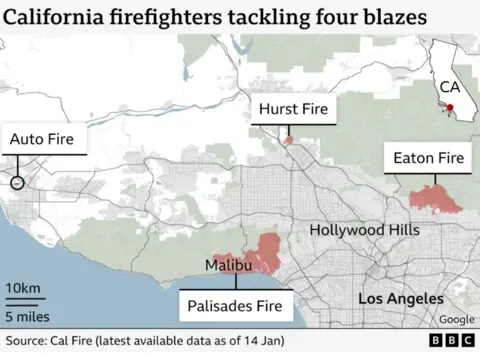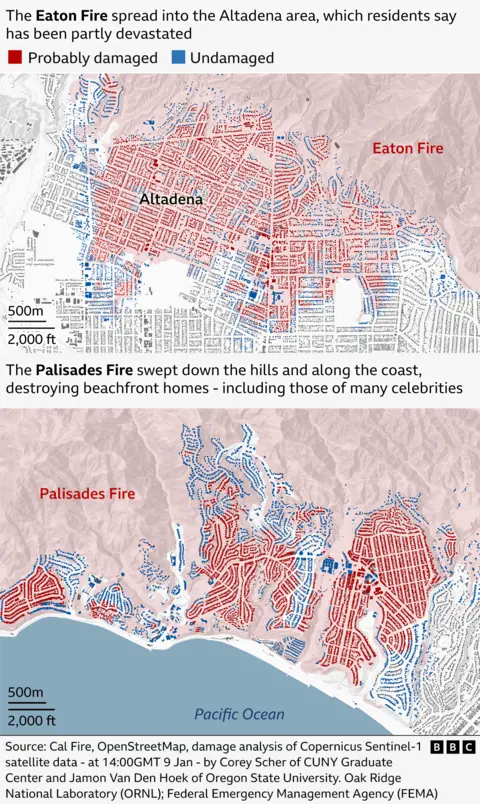Firefighters battling two fires that have wreaked havoc across Los Angeles for nine days got some relief Thursday from the weather.
The near hurricane-force winds that initially sparked the fires and hampered rescue efforts have weakened to much lighter winds.
Progress has been made in containing the two largest fires burning totaling about 40,000 acres.
At least 27 people were killed and more than 12,000 structures were destroyed in some of the worst fires in memory to sweep through America’s second-largest city.
The two largest fires, Eaton and Palisades, are still burning more than a week later — and firefighting help has been requested from Mexico and Canada.
“Please be assured that our firefighters continue to work 24/7 to achieve full containment of these wildfires as quickly as possible,” Los Angeles County Fire Chief Anthony Marrone said during a news conference Thursday morning.
Officials said there had been little fire growth over the past 24 hours, but stressed that dry, unburned fuel with low humidity could pose threats despite low winds.
While first responders are making progress in dousing the fire, evacuated residents will not be able to return to their neighborhoods for at least another week, even in areas deemed safe, Mr. Marrone said.
About 82,400 Californians are under evacuation orders, according to Los Angeles County Mayor Robert Luna.
Luna said 47 people were arrested in connection with looting, local evacuation orders and curfew violations.
Later Thursday afternoon, evacuation orders were lifted for some communities affected by the Palisades Fire and Eaton Fire — more than a week after the orders were first issued.
Authorities said residents must prove their residency with a government-issued ID card to be allowed into the affected areas. They also advise residents to wear protective clothing, including gloves and a mask, and avoid contact with potentially toxic ash.
“Coming back after a fire can be overwhelming,” the Altadena Sheriff’s Station said in a recent Facebook post offering advice for returning evacuees.
“Take breaks, reach out to loved ones, and consider talking to a counselor or support group if necessary.”
The National Weather Service (NWS) has lifted red flag warnings, but they may return in a few days.
Fire warnings remain critical, with parts of Southern California still seeing increased risks despite weak winds and high humidity, says BBC meteorologist Paul Goddard.
There is no rain forecast for California over the next week.
Officials are monitoring Santa Ana winds, which are blamed for fanning the fires. The winds are expected to return early next week, raising the risk of more red flag warnings.
Wind speeds can reach 30-50 mph (48-80 km/h).
The Palisades Fire, the largest, has not seen any growth as firefighters work to contain the flames, according to Jim Hudson, Cal Fire incident manager.
It has burned 24,000 acres so far and was more than 20% contained as of Thursday morning.
“I am hopeful that as the winds calm, we can see a light at the end of the tunnel, and individuals can get their lives back on track to recover and rebuild,” Los Angeles Mayor Karen Bass said Thursday.
But there are still many dangers to the area, even as firefighters make progress.
Hudson added that 5,100 personnel were assigned to contain the fire.

Los Angeles officials confirmed to the BBC that two more people died due to the fires on Thursday. There are at least 31 active missing persons reports in Los Angeles County as of Thursday.
Most of the victims died in the Eaton Fire, which burned more than 14,000 acres north of the city. Firefighters were able to contain 55% of the fire.
Some victims of the Eaton fire have now been allowed to return to their homes, but tens of thousands of people are still under evacuation orders – with a night-time curfew also in place.
Thousands of homes were destroyed in one of the costliest natural disasters in American history.
Study of extreme weather attribution by climate scientists in ‘Climate scaleHe concluded that the California wildfires were fueled by meteorological conditions enhanced by human-induced climate change.
The study found that current conditions were warmer, drier and windier than in the past, in fire-affected areas.

https://ichef.bbci.co.uk/news/1024/branded_news/6e81/live/4f5f5df0-d410-11ef-9fd6-0be88a764111.jpg
Source link
